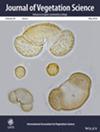Plant Invasions Reduce the Degree of Nestedness on Warm Temperate Islands
Abstract
Questions
Understanding the composition and structure of island floras is crucial for making informed conservation decisions, especially in the context of biological invasions. Island floras are often nested, that is, species-poor assemblages are frequently subsets of species-rich ones. However, the circumstances under which this occurs on islands are often unclear. To gain insight into the processes that shape the composition and structure of island floras, we incorporated taxonomic and trait categories to investigate the relationships between the degree of nestedness of native and non-native plant species and island characteristics. We hypothesise that the degree of nestedness (1) declines with island area (non-random local extinctions), increases with isolation (non-random colonisation), declines with exposure to ocean-borne disturbances (non-random local extinction of specialists with their habitat) and is higher on volcanic compared to sedimentary islands (assembly rules). We also hypothesise that (2) plant invasions will reduce overall nestedness and (3) plant assemblages will be more nested if smaller in size (e.g., grasses, forbs) and not adapted to long-distance dispersal (e.g., wind-dispersed, ferns).
Location
Two hundred and sixty-four islands offshore from northern Aotearoa New Zealand.
Methods
We combined field surveys and published data for 1543 native and non-native plant species across 264 islands. We compiled information about taxonomy at the fine (species) and coarse level (i.e., ferns and allies, conifers, monocots and dicots) and categorised each species by its growth form (i.e., graminoids, forbs, woody species, climbers and lianas and epiphytes) and dispersal mode (i.e., water-dispersed, unspecialised, short-distance, animal-dispersed and wind-dispersed). We quantified nestedness by organising species incidence matrices using the NODF (i.e., nestedness metric based on overlap and decreasing fill) and fixed-fixed null models. Finally, we related island nestedness ranks with four island characteristics (area, isolation, exposure to ocean-borne disturbances and geological origin).
Results
Nearly all plant categories were nested, with a few exceptions. However, non-native species reduced the overall degree of nestedness. Nestedness ranks were consistently related to island area and largely to exposure to ocean-borne disturbances, but rarely to isolation and geological origin. These results strongly support the selective extinction (i.e., small, species-poor islands are subsets of larger, species-rich islands due to non-random local extinctions) and habitat nestedness (i.e., nested patterns generated by the non-random local extinction of specialists with their habitat) hypotheses.
Conclusions
Non-native plant species reduce the overall degree of nestedness, modifying the species composition of island floras. The overarching effect of island area in shaping insular plant composition underscores the key role of large islands for conserving plant diversity. Nestedness studies can suggest probable processes that determine insular community composition and aid in identifying high-priority islands for conservation.


 求助内容:
求助内容: 应助结果提醒方式:
应助结果提醒方式:


